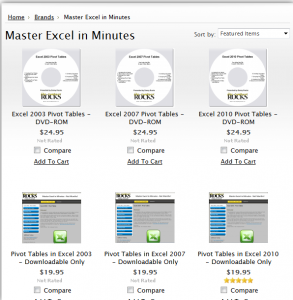 I am proud to announce that my online store for The Company Rocks is now open!
I am proud to announce that my online store for The Company Rocks is now open!
You can now purchase my two DVDs without leaving my website.
“The 50 Best Tips for Excel 2007” contains over 5 1/2 hours of training. Each video lesson focuses on one tip and you can learn it in @ 6 minutes! The tips range from Beginning Level to the Advanced level. The majority of Tips (30 tips) are at the Intermediate level. If you enjoy the lessons that I post here, now you can own a DVD of the 50 Best Tips – now for Excel 2007!
“The 50 Best Tips for PowerPoint 2007” contains over 7 hours of training on two DVDs! I put a lot of effort into producing this DVD – and the customers who have already purchased it tell me that has immediately improved their presentation skills.
This DVD is unique!
Because, I do not teach PowerPoint as a “techie.” Rather, I am a professional speaker and trainer and I show you how to use PowerPoint as a tool to use during your presentations. Of course I show you how to create animations and how to create custom PowerPoint shows. But, significantly, I demonstrate how best to use custom animations and why you should prepare Custom PowerPoint shows. If you think you know PowerPoint, think again. I guarantee that you will learn new techniques for PowerPoint and … you will learn how to take advantage of the many great new graphic features available in PowerPoint 2007.
I invite you to visit my online store. The DVDs are in stock and attractively priced. I know that you will learn new tips and refine your skills in PowerPoint and Excel when you watch one of my lessons.
- Invest 10 minutes to learn a new productivity tip – and, save yourself hours of frustration and avoid having to rekey data entries in Excel 2007.
- Invest 10 minutes to learn a new presentation tip – and, learn how to deliver presentations using PowerPoint 2007 that get you the sale or get your audience to take action.
- Invest 10 minutes and learn how to use the new Office 2007 interface. I show you how to always have your favorite commands right at your fingertips.
Finally, let me wish you a very Happy New Year in 2010!
Sincerely,
Danny Rocks
danny@thecompanyrocks.com



